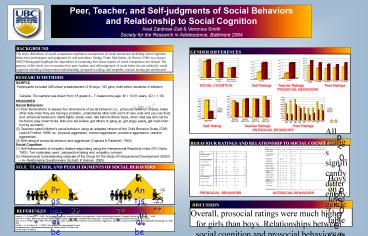36x48 vertical poster template - PowerPoint PPT Presentation
1 / 1
Title:
36x48 vertical poster template
Description:
Anat Zaidman-Zait & Veronica Smith. Society for the Research in Adolescence, Baltimore 2004. The many definitions of social competence emphasize components of social ... – PowerPoint PPT presentation
Number of Views:866
Avg rating:3.0/5.0
Title: 36x48 vertical poster template
1
Peer, Teacher, and Self-judgments of Social
Behaviors and Relationship to Social
Cognition Anat Zaidman-Zait Veronica
Smith Society for the Research in Adolescence,
Baltimore 2004
BACKGROUND
GENDER DIFFERENCES
The many definitions of social competence
emphasize components of social interaction
including social cognition, behavioral
performance and judgments by self and others.
Dodge, Pettit, McClaskey, Brown (1986) in a
classic SRCD Monograph highlight the importance
of examining how these aspects of social
competence are related. The purpose of this study
was to examine how peer, teacher, and
self-judgments of social behaviors are related to
social cognition including interpersonal
understanding, perspective taking, and empathic
concern among pre-adolescents
SOCIAL COGNITION
Self Ratings Teacher Ratings
Peer Ratings PROSOCIAL
BEHAVIORS Self
Rating Teacher
Ratings Peer Ratings
ANTISOCIAL BEHAVIORS
RESEARCH METHODS
- SAMPLE
- Participants included 409 urban preadolescent
(216 boys, 193 girls) multi-ethnic students in
Western Canada. The sample was drawn from 18
grade 4 7 classrooms (age M 10.81 years, SD
1.18). - MEASURES
- Social Behaviors
- Peer Nominations to assess two dimensions of
social behavior (i.e., prosocial behavior
shares, helps other kids when they are having a
problem, understands other kids point of view,
kids who you can trust and, antisocial
behaviors starts fights, break rules, talk
behind others back, when mad say lets not be
his friend, play mean tricks, kids who are
bullies, get others to gang up, get angry easily,
get mad when hurt by accident) - Teachers rated childrens social behavior using
an adapted version of the Child Behavior Scale
(CBS Ladd Profilet, 1996) (ie., physical
aggression, indirect aggression, proactive
aggression, reactive aggression). - Self rating of prosocial behavior and aggression
(Caprara Pastorelli, 1993) - Social Cognition
- Self Assessments of empathy related responding
using the Interpersonal Reactivity Index (IRI
Davis, 1983). Two subscales used perspective
taking and empathic concern. - Interpersonal Understanding subscale of the
Group for the Study of Interpersonal Development
(GSID) 4 Relationship Questionnaire (Schultz
Selman, 2000). - PROCEDURE Child measures were group administered
All ratings significantly different by gender
BEHAVIOUR RATINGS AND RELATIONSHIP TO SOCIAL
COGNITION
PROSOCIAL
BEHAVIORS ANTISOCIAL BEHAVIORS
SELF, TEACHER, AND PEER JUDGMENTS OF SOCIAL
BEHAVIORS
Boys on lower table Girls on upper table
DISCUSSION
REFERENCES
Overall, prosocial ratings were much higher for
girls than boys. Relationships between social
cognition and prosocial behaviors as reported by
self and peers were significant both girls and
boys. Teacher ratings of prosocial behaviour in
boys were related to social cognition however,
no significant relationship was found for
teacher rating of prosocial behavior and social
cognition for girls. Self and peer ratings of
behavior were more closely related. These results
may reflect a different conceptualization of
prosocial behaviour of girls. Overall,
antisocial ratings were much higher for boys than
girls. Relationships between social cognition and
antisocial behavior as reported by self and
teachers were significant for both girls and
boys. Peer ratings for girls were not related to
social cognition.
Caprara, J. V. Pastorelli, C. (1993). Early
emotional instability, prosocial behavior, and
aggression Some methodological aspects. European
Journal of Personality, 7, 19-36. Davis, M. H.
(1983). Measuring individual differences in
empathy Evidence for multidimensional approach.
Journal of Personality and School Psychology, 44,
113-126. Ladd, G. W. Profilet, S. M. (1996).
The Child Behavior Scale A teacher-report
measure of young childrens aggressive,
withdrawn, and prosocial behaviors. Developmental
Psychology, 32, 1008-1024. Schultz, L. H.,
Selman, R. L. (2000). The meaning and
measurement of social competence from a
developmental perspective, Working Paper 153 (New
York, Russell Sage Foundation).































